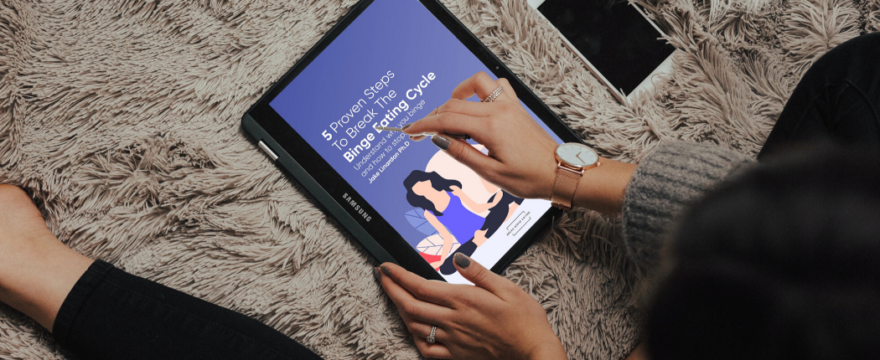Looking for help for binge-eating disorder can be daunting. You mightn’t know where to look, what type of help to get, and what’s involved.
Seeking professional help, although highly beneficial, comes with its problems, like being very expensive, having to be put on waiting lists, and even having to travel long distances.
Making matters worse, more than 75% of people with an eating disorder do not receive professional help because of these barriers! 1wHart, L. M., Granillo, M. T., Jorm, A. F., & Paxton, S. J. (2011). Unmet need for treatment in the eating disorders: a systematic review of eating disorder specific treatment seeking among community cases. Clinical psychology review, 31, 727-735.
Because of this, we’d like to discuss the concept of self-help and how you could use the stepped-care approach when starting the process of binge eating recovery.
Table of Contents
What is Self-Help?
Self-help means doing it yourself.
It means going through and implementing the steps of a treatment program by yourself, with or without some small guidance with a professional.
While “treating yourself” can be a scary proposition, evidence shows that self-help approaches can be very effective for binge-eating disorder.
In fact, research has shown that up to 40% of people with binge-eating disorder fully recover after a self-help program, while many more experience at least some improvements 2Linardon, J. (2018). Rates of abstinence following psychological or behavioral treatments for binge-eating disorder: Meta-analysis. International Journal of Eating Disorders, 1-13. doi:10.1002/eat.22897.
The self-help program usually comes in the form of a book or a website, which provides some important steps and strategies to help you overcome binge eating.
Most self-help programs are based on cognitive-behavioural therapy, but others on dialectical behaviour therapy and mindfulness also exist.
Self-Help as the First Step
Engaging in a self-help program is the ideal first step you could take towards recovering from binge eating.
This is because the self-help resource can be accessed freely or cheaply, it doesn’t require you to see a trained therapist, and you can complete the program at a time, pace, and location of your choice.
And, more importantly, if you find that the self-help approach has worked for you, then you’ve potentially saved a lot of time and hundreds of dollars!
But, if you find that the self-help approach isn’t for you, then you can go out and seek the professional help you might need.
This is called the “stepped care approach”
It means that everyone starts off with the least intensive resources, like a self-help book, and for those who don’t respond to this “step-up” to a more intensive treatment, like face-to-face therapy with a psychologist.
The stepped-care approach has enormous benefits to you, the client, and also has enormous benefit to healthcare system, like preserving our finite resources (e.g., therapists, treatment centres, hospital rooms etc.) to those who are in desperate need.
So…What Self-Help Treatment Should I Use?
Great Question!
Luckily here at Break Binge Eating, we’ve written our own self-help e-book, currently being used by 8,000+ people!
This e-book contains 5 practical steps to help you overcome binge eating, based on the principles, techniques, and assumptions of cognitive-behavioral therapy.
Here’s a sneak peak of the 5 steps;
1. Understanding yourself
Where you’re taught how to act like a detective, searching for clues about your binge eating experience and all of the factors that trigger you to binge. Understanding yourself is the most important step of binge eating recovery, and we’ll teach you how to accomplish this.
2. Eating regularly and flexibly
If you binge, it’s likely that you’ve got very unstructured eating patterns, cycling through episodes of undereating, overeating, grazing, and binge eating. Step 2 is designed to help you develop some much-needed structure around eating.
3. Learning effective problem solving
We recognise that emotions trigger episodes of binge eating. To break binge eating, you need to learn how to adopt healthier coping strategies, which is what Step 3 is designed for.
4. Overcoming the food anxiety
If you fear certain foods or have a list of “forbidden food”, then this step is for you. Because forbidden foods can sometimes set us off and cause us to binge, this step will help you fight your food anxieties and feel “safe” around trigger foods.
5. Discover your new passion
You’ll learn that binge eating stems from low self-worth, so the final step of this book will help increase your self-esteem and self-worth. We’ll provide guidance on how to achieve this, with particular emphasis on the importance of developing new hobbies.
Hopefully you’re on board with the stepped-care, self-help approach to binge eating disorder treatment.
You don’t need to look any further for your self-help resources – we’ve got them right here for you.
Access your copy of the eBook free above.
References

🙂
How do I get this ebook?
Hey Mia,
At the bottom of the website we have a ‘Sign Up Today’ button which will take you straight to the eBook. Any issues just let me know.
– Jake